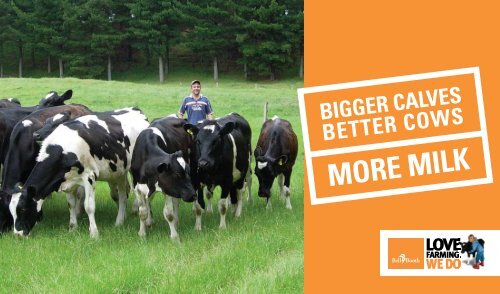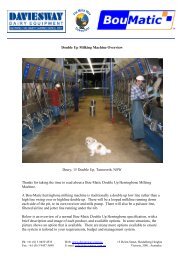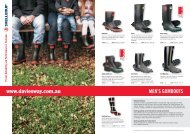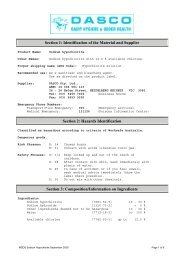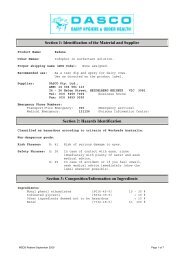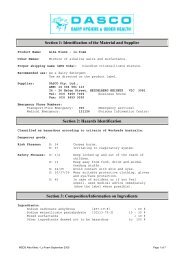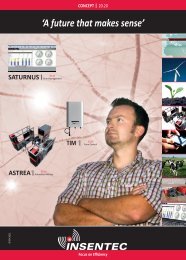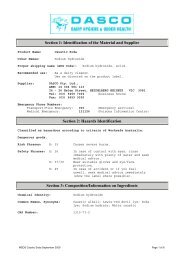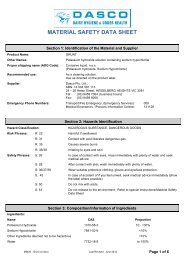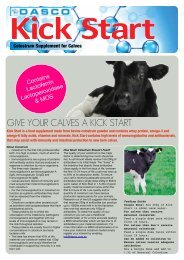to download the brochure about Queen of Calves as a pdf.
to download the brochure about Queen of Calves as a pdf.
to download the brochure about Queen of Calves as a pdf.
- No tags were found...
Create successful ePaper yourself
Turn your PDF publications into a flip-book with our unique Google optimized e-Paper software.
BIGGER CALVESBETTER COWSMORE MILK
2Have a look at <strong>the</strong> picture on <strong>the</strong> next page…It tells <strong>as</strong><strong>to</strong>ry <strong>of</strong> <strong>the</strong> <strong>Queen</strong> <strong>of</strong> <strong>Calves</strong> Programme . One <strong>of</strong> manycalving success s<strong>to</strong>ries that we love being part <strong>of</strong> atBell-Booth. And it’s a tale that could be yours <strong>to</strong>o...If you want <strong>to</strong> grow bigger calves,that produce better cows, withmore milk, our <strong>Queen</strong> <strong>of</strong> <strong>Calves</strong>programme h<strong>as</strong> shown time andtime again that it delivers justthat… And it can for yourcalves <strong>to</strong>o.Hi, I’m Stephen Bell-Booth andthis year we celebrate 50 yearsin business.Nigel Taylor h<strong>as</strong> raised all his replacements for <strong>the</strong> p<strong>as</strong>t 4 years(autumn and spring) on <strong>the</strong> <strong>Queen</strong> <strong>of</strong> <strong>Calves</strong> Programme. Thesecalves were weaned at 9 weeks, weighing 90kg on average. At <strong>the</strong>same time <strong>the</strong>y were put on <strong>the</strong> run<strong>of</strong>f (<strong>the</strong> piece <strong>of</strong> land <strong>the</strong>y’restanding on) and were <strong>the</strong>re until 2 weeks prior <strong>to</strong> calving.At 6 months old, (pictured on <strong>the</strong> cover and amongst <strong>the</strong> groupon <strong>the</strong> right) <strong>the</strong>se babies cr<strong>as</strong>hed <strong>the</strong> fence and got in with <strong>the</strong>bought-in yearlings that were not raised on a <strong>Queen</strong> <strong>of</strong> <strong>Calves</strong>Programme. Later <strong>the</strong> vet came <strong>to</strong> check on <strong>the</strong> yearlings. She w<strong>as</strong>unaware <strong>of</strong> <strong>the</strong> mix up and w<strong>as</strong> slightly concerned some <strong>of</strong> <strong>the</strong>yearlings were a bit small <strong>to</strong> put <strong>to</strong> <strong>the</strong> bull. Nigel tried <strong>to</strong> explain<strong>to</strong> <strong>the</strong> vet <strong>the</strong>y were only 6 months old. She didn’t believe him...Orange tags are yearlings and yellow tags 6mth old calves.
3“Here’s living pro<strong>of</strong> <strong>of</strong> biggercalves, becoming better cowsthat produce more milk”NIGEL TAYLORDairy farmer, ManawatuBigger really is better. Pictured here at 22 months,<strong>the</strong>se heifers (pictured <strong>as</strong> calves aged 6 months oncover and page 2) averaged 535 kilograms. Theyentered <strong>the</strong> milking herd at over 90% <strong>of</strong> <strong>the</strong>ir potentialmature liveweight and produced 29% more milk than<strong>the</strong>New Zealand average. Here’s living pro<strong>of</strong> <strong>of</strong> biggercalves, becoming better cows that produce more milk.
4Thanks for reading on...• The experts tell us we get one shot at it.• The first 12 weeks. It’s make or break.• If we get that bit right, calves willintegrate in<strong>to</strong> <strong>the</strong> herd like <strong>the</strong>y own<strong>the</strong> farm.• They’ll milk well.• And <strong>the</strong>y’ll reproduce. Even <strong>as</strong> secondyear calvers.Something <strong>to</strong> ponder.In <strong>the</strong> se<strong>as</strong>on just gone, <strong>the</strong> average R2 Friesian/Holsteinweighed 398kg. That means <strong>the</strong> majority <strong>of</strong> our nation’scows entered <strong>the</strong> milking herd at approximately 75%<strong>of</strong> <strong>the</strong>ir potential mature liveweight. This is a clearopportunity for improvement. And it’s not difficult orexpensive <strong>to</strong> achieve a 90% potential maturity at R2.Growing bigger calves will make a pr<strong>of</strong>ound difference.
5QUEEN OF CALVES DELIVERSBIGGER CALVES<strong>Calves</strong> RAISED on <strong>Queen</strong> <strong>of</strong><strong>Calves</strong>, reached <strong>the</strong>ir targetIn a closed-loop 2007 Feed Conversion Study, conductedby M<strong>as</strong>sey University, researchers found that sameprogeny calves <strong>of</strong> identical birth weight fed an identicaldiet, grew bigger and quicker, when <strong>the</strong> daily wholemilkw<strong>as</strong> supplemented with <strong>the</strong> high energy, highly digestible<strong>Queen</strong> <strong>of</strong> <strong>Calves</strong> feed. The treated calves reached <strong>the</strong>irtarget weaning weight 8 days earlier, and required lessfeed <strong>to</strong> get <strong>the</strong>re – 16% less meal and 9% less milk.Figure 1. Daily hip width development.63mm daily growth.78mm daily growthweaning weight 8 days earlier,and required less fEED <strong>to</strong> get<strong>the</strong>re – 16% less meal and 9%less milk.M<strong>as</strong>sey used daily hip width me<strong>as</strong>urements <strong>as</strong> <strong>the</strong>determining comparison for skeletal growth. At 12 weeks<strong>of</strong> age, <strong>the</strong> treated calves had produced an average dailyhip width growth <strong>of</strong> .78mm per day. The untreated calvesgrew .63mm per day.
6BIGGER CALVES PRODUCEBETTER COWSThese are better cows. Only because <strong>the</strong>ywere raised on <strong>Queen</strong> <strong>of</strong> <strong>Calves</strong>.Born in <strong>the</strong> spring <strong>of</strong> 2006, mos<strong>to</strong>f Colin and Shelley Pope’s calveswere very sick due <strong>to</strong> a dev<strong>as</strong>tatingrotavirus outbreak in <strong>the</strong> shed. Toquote Shelley, “It w<strong>as</strong> depressingand dev<strong>as</strong>tating, and we struggled<strong>to</strong> get on <strong>to</strong>p <strong>of</strong> it.” If you’veexperienced <strong>the</strong> effects <strong>of</strong> rotaviruson your farm, it’s fair <strong>to</strong> say thosecalves generally never do well<strong>as</strong> milkers. And you’d hardly line<strong>the</strong>m up <strong>to</strong> be pho<strong>to</strong>graphed for a<strong>brochure</strong>, would you!Colin and Shelley say “They were<strong>the</strong> first calves <strong>to</strong> be raised on <strong>the</strong><strong>Queen</strong> <strong>of</strong> <strong>Calves</strong> Programme andare now being milked. We’re veryple<strong>as</strong>ed with <strong>the</strong>ir production andgrowth, especially considering how<strong>the</strong> virus knocked <strong>the</strong>m <strong>about</strong>.”According <strong>to</strong> <strong>the</strong> Popes, this year’scalves have good body frames andlarge appetites.“They’ve got suchlarge appetites!”Colin & Shelley PopeDairy farmers, Kaponga, Taranaki
7BETTER COWS PRODUCEMORE MILKSomething <strong>to</strong> ponder.If a 400 cow Friesian herd, with a 25% replacement policy,producing milk at <strong>the</strong> national average 08/09 level could lift <strong>the</strong>production <strong>to</strong> just <strong>the</strong> average performance <strong>of</strong> <strong>the</strong> herds using a<strong>Queen</strong> <strong>of</strong> <strong>Calves</strong> programme, <strong>the</strong>n on a $6.05 payout <strong>the</strong> incre<strong>as</strong>ed49 kilograms additional milksolids/heifer (year 1) would equate <strong>to</strong>ano<strong>the</strong>r $295/heifer/se<strong>as</strong>on or, an additional $30,000 more grossrevenue per year.And in <strong>the</strong> second lactation, those cows could produce ano<strong>the</strong>r58 kg/MS, bringing an additional $35,000 gross revenue.6,900 cow studyPr<strong>of</strong>essor Chris Triggs, Head <strong>of</strong>Statistics, Auckland UniversityIn a study involving 6,900 dairy cows<strong>of</strong> all <strong>the</strong> major breed types that wereraised on <strong>Queen</strong> <strong>of</strong> <strong>Calves</strong>, Pr<strong>of</strong>essorChris Triggs, Head <strong>of</strong> Department,Department <strong>of</strong> Statistics, Faculty <strong>of</strong>Science, The University <strong>of</strong> Auckland,compared <strong>the</strong> daily milk production <strong>of</strong><strong>the</strong>se cows against given breeds andyear with <strong>the</strong> comparable publishednational LIC data for that year for allLIC herds. In Pr<strong>of</strong>essor Triggs opinion,analysis <strong>of</strong> <strong>the</strong> data shows that <strong>the</strong>sefirst year milking cows producedon average 18.4% additional dailymilksolids compared <strong>to</strong> <strong>the</strong> 2007/08published New Zealand nationalaverage data from LIC. In <strong>the</strong>ir secondlactation, <strong>the</strong>se cows produced 18.8%additional daily milksolids using <strong>the</strong>same reference.Pr<strong>of</strong>essor Triggs is currently studying<strong>the</strong> data from a survey involving 10,000cows <strong>of</strong> major breed types, raised on a<strong>Queen</strong> <strong>of</strong> <strong>Calves</strong> Programme, details <strong>of</strong>which will be posted on <strong>the</strong>www.queen<strong>of</strong>calves.com website.Supporting DataIn first lactation:100 x 2 year heifers@265 kg/MS (LIC national average milk production 2007/08)@314 kg/MS (<strong>Queen</strong> <strong>of</strong> <strong>Calves</strong> average milk production 2007/08)Total additional revenue/heifer = $295 in first lactationIn second lactation:100 x 3 year heifers@307 kg/MS (LIC national average 2007/08)@365 kg/MS (<strong>Queen</strong> <strong>of</strong> <strong>Calves</strong> average 2007/08)Total additional revenue/heifer = $350 in second lactationTotal revenue at <strong>the</strong> end <strong>of</strong> two year period is $645/heifer frominvesting in an additional $9.00/calf <strong>to</strong> implement a <strong>Queen</strong> <strong>of</strong><strong>Calves</strong> Programme.
8THE LATESTRESEARCHMore efficient digestion<strong>Queen</strong> <strong>of</strong> <strong>Calves</strong> is a micr<strong>of</strong>ine powder. It’s made from highlydigestible foods and <strong>the</strong> way it digests in<strong>to</strong> <strong>the</strong> animal’s system isvery unique. Because <strong>Queen</strong> <strong>of</strong> <strong>Calves</strong> is added <strong>to</strong> <strong>the</strong> milk and <strong>the</strong> calfsucks <strong>the</strong> mixture via a teat, <strong>the</strong> milk and <strong>the</strong> feed are delivered directlyin<strong>to</strong> <strong>the</strong> simple s<strong>to</strong>mach (abom<strong>as</strong>um). Normally, when <strong>the</strong> calf eats, <strong>the</strong>feed goes <strong>to</strong> <strong>the</strong> rumen.Evidence suggests that through this unique delivery mechanism, <strong>the</strong>energy conversion ratio is <strong>about</strong> 42% more efficient than a conventionalcarbohydrate conversion process. In practical terms, adding <strong>Queen</strong> <strong>of</strong><strong>Calves</strong> energises a calf’s diet enabling it <strong>to</strong> reach weaning weight up <strong>to</strong>14 days earlier * . This saves a lot <strong>of</strong> labour, milk and meal.*M<strong>as</strong>sey University <strong>Queen</strong> <strong>of</strong> <strong>Calves</strong> Trial 2006Reduced methane emissionsThe addition <strong>of</strong> <strong>Queen</strong> <strong>of</strong> <strong>Calves</strong> produces more frame andless g<strong>as</strong>.Because methane is generated in <strong>the</strong> rumen, and <strong>Queen</strong> <strong>of</strong> <strong>Calves</strong> isdeposited in<strong>to</strong> <strong>the</strong> simple s<strong>to</strong>mach, less methane is produced duringfeeding. A preliminary feed intake analysis by research consultancyCatalyst R&D Ltd estimated that at weaning <strong>the</strong>re may be areduction in methane emissions <strong>of</strong> up <strong>to</strong> 0.21 kg 1 for a calf raisedon a <strong>Queen</strong> <strong>of</strong> <strong>Calves</strong> Programme compared <strong>to</strong> a calf raised on anidentical diet less <strong>Queen</strong> <strong>of</strong> <strong>Calves</strong>.For a mob <strong>of</strong> 200 replacements raised on a <strong>Queen</strong> <strong>of</strong> <strong>Calves</strong>Programme <strong>the</strong>se reductions in methane emissions would be 41kg.This h<strong>as</strong> <strong>the</strong> equivalent greenhouse warming potential <strong>of</strong> 880kg CO 2– <strong>the</strong> same <strong>as</strong> that produced by driving a medium sized petrol carfrom Auckland <strong>to</strong> Welling<strong>to</strong>n 6 times, or burning 450kg coal.1B<strong>as</strong>ed on a calf emission fac<strong>to</strong>r <strong>of</strong> 19.75 kg methane per kg DMI
9“It makes a realdifference.”Gavin & Sally RodenDairy farmers, Waiuku, South AucklandIn practical terms,this is not only good for<strong>the</strong> calf – it’s good for<strong>the</strong> country
10FAQsQ.1A.1Will my cows produce 18% more milk just by changing <strong>to</strong> a<strong>Queen</strong> <strong>of</strong> <strong>Calves</strong> programme?Likely. O<strong>the</strong>r fac<strong>to</strong>rs like dise<strong>as</strong>e prevention, p<strong>as</strong>ture management and shed set-up will influence your results.Q.2A.2We’re already a high producer. What’s our chance <strong>of</strong> incre<strong>as</strong>ingmilk production by 18%?The chances are good because you already have <strong>the</strong> infr<strong>as</strong>tructure and ability <strong>to</strong> raise high-producingcows. There are many <strong>to</strong>p-producing dairy farms throughout New Zealand and Australia that have changed <strong>to</strong> <strong>the</strong><strong>Queen</strong> <strong>of</strong> <strong>Calves</strong> programme, and <strong>the</strong>ir evidence shows milk production h<strong>as</strong> incre<strong>as</strong>ed. Some farms have exceeded thatfigure. But even if you achieved just 5%, that extra revenue would pay back your investment in <strong>the</strong> programme manytimes over.
11Q.3A.3My vet knows <strong>about</strong> <strong>the</strong> research work but wants <strong>to</strong> know more<strong>about</strong> <strong>the</strong> make up <strong>of</strong> <strong>the</strong> product?<strong>Queen</strong> <strong>of</strong> <strong>Calves</strong> is a probiotic and nutritional derived from land and sea plant extracts.X-Fac<strong>to</strong>r is a probiotic. Both products were developed within Bell-Booth Limited and are trade secrets.Therefore we cannot disclose formulation details.Q.4A.4I’ve heard it’s hard <strong>to</strong> mix. Correct?No. There are e<strong>as</strong>y <strong>to</strong> follow mixing instructions on every bag and it is e<strong>as</strong>y <strong>to</strong> mix. But <strong>as</strong> nothing’s<strong>as</strong> e<strong>as</strong>y <strong>as</strong> pouring milk out <strong>of</strong> <strong>the</strong> vat in<strong>to</strong> a calfateria, if you want good results, make sure your staffappreciate <strong>the</strong> benefits <strong>of</strong> <strong>the</strong> programme and follow simple procedure:(1) Pour <strong>the</strong> powder in a bucket (2) Hose with water <strong>to</strong> hydrate (3) Leave overnight.Q.5A.5I run a low input farming system. How can it work for me?(1) To raise a replacement calf on a <strong>Queen</strong> <strong>of</strong> <strong>Calves</strong> Programme costs $9.00 ** more per calf than a traditionalmilk and meal programme, this is without fac<strong>to</strong>ring any labour savings gained from 8-14 days earlier weaning.(2) Research suggests <strong>the</strong> opportunity cost <strong>of</strong> not achieving early weaning is evidenced in (a) lower R3 reproduction, (b) nomilk production from heifers that failed <strong>to</strong> mate because <strong>of</strong> poor skeletal growth, and (c) <strong>the</strong> cost <strong>of</strong> grazing empty cows forano<strong>the</strong>r 12 months. If we conservatively estimate that cost at $3,000 per cow, how can you afford not <strong>to</strong>?* & ** See page 13 for full details
12Something <strong>to</strong> ponder.For farmers who run low-input systems.We have studied a number <strong>of</strong> models involving <strong>the</strong>use <strong>of</strong> <strong>Queen</strong> <strong>of</strong> <strong>Calves</strong> fed with low milk rates. Andwhen we first started <strong>the</strong> programme, we promoted alow milk model because <strong>of</strong> <strong>the</strong> cost savings. But we’reconvinced by <strong>the</strong> research and <strong>the</strong> anecdotal evidencethat <strong>the</strong> lifetime benefits <strong>as</strong>sociated with providing acalf a balanced, high energy and high ME (metabolisableenergy) nutrition outweigh any cost savings from a lowinput scheme. Lifetime economics, better milk productionand better fertility.
13WHAT’S THE COSTCOMPARISON?ProgrammeWHOLEMILKMEAL /PELLETSSTRAW /HAYX-FACTORQUEEN OFCALVESDAYS TOWEANINGTOTAL COSTPER CALFTraditionalProgramme<strong>Queen</strong> <strong>of</strong> <strong>Calves</strong>Programme4L/day 50kg 1 bale - - 70 $2404L/day 38kg 1 bale 50g/day 200g/day 63 $249Additional investment in a <strong>Queen</strong> <strong>of</strong> <strong>Calves</strong> Programme is only $9In our 50 years <strong>of</strong> business we’ve worked with literally thousands <strong>of</strong> farmers andin recent years have collated a substantial amount <strong>of</strong> calf rearing data.A standard dairy heifer replacement diet consists <strong>of</strong> milk, meal and straw and runs for 10-12 weeks. A <strong>Queen</strong> <strong>of</strong><strong>Calves</strong> Programme consists <strong>of</strong> milk, meal and straw with <strong>the</strong> addition <strong>of</strong> X-Fac<strong>to</strong>r for <strong>the</strong> first 18 days and <strong>Queen</strong><strong>of</strong> <strong>Calves</strong> from Day 19 <strong>to</strong> weaning and runs for 9 weeks.A $9 incre<strong>as</strong>e in feed investment canpotentially yield a $295 ** additional return in <strong>the</strong>first lactation.ADDITIONAL COST: 100 calves x $9 = $900ADDITIONAL GROSS REVENUE: 100 heifers x $295 = $29,500IMPROVED PROFIT: $28,600* B<strong>as</strong>ed on a payout <strong>of</strong> $6.05/kg/MS and calfmeal prices <strong>as</strong> <strong>of</strong> February 2010.** B<strong>as</strong>ed on <strong>the</strong> average milk yields me<strong>as</strong>ured over 6,900 cows reared on<strong>the</strong> <strong>Queen</strong> <strong>of</strong> <strong>Calves</strong> Programme, when compared with <strong>the</strong> national herdaverage and a $6.05 payout.
14BIGGER CALVESBETTER COWSMORE MILKIt all adds upThe Dairy Industry h<strong>as</strong> spent many millions <strong>of</strong> dollarsresearching genetics, au<strong>to</strong>mation, management systems anddise<strong>as</strong>e prevention. But <strong>the</strong>re is a large gulf in studying <strong>the</strong>early nutrition requirements <strong>of</strong> high performance genetics.We believe that <strong>the</strong> early <strong>Queen</strong> <strong>of</strong> <strong>Calves</strong> research work by M<strong>as</strong>seyUniversity clearly shows that raising high performance calves ona traditional low FME diet <strong>of</strong> milk and meal deprives <strong>the</strong>m <strong>of</strong> <strong>the</strong>energy <strong>the</strong>y need <strong>to</strong> reach <strong>the</strong>ir genetic potential.The experts say that if we get <strong>the</strong>first 12 weeks wrong, we can neverrecover that lost opportunity.In practical terms, a slowermaturingcalf transitions in<strong>to</strong> <strong>as</strong>maller-framed, less productiveand reproductive cow for life.At Bell-Booth we’re serious <strong>about</strong> calf nutritionand <strong>the</strong> link <strong>to</strong> milk production. If you’re serious,our product specialists are trained <strong>to</strong> help yougrow your replacement calves in<strong>to</strong> high-producingand reproducing cows.Talk <strong>to</strong> us <strong>to</strong>day <strong>about</strong> how <strong>Queen</strong><strong>of</strong> <strong>Calves</strong> can help you set your herdup for life – call 0800 80 90 91 andstart this se<strong>as</strong>on.For specific feeding guidelinesand technical information visitwww.queen<strong>of</strong>calves.com
15“It really works.”Alan & Paula Bryant & son CameronDairy farmers, Te Awamutu, Waika<strong>to</strong>
BIGGER CALVESBETTER COWSMORE MILKBell-Booth Limited15 Tiki Place, Palmers<strong>to</strong>n North, New ZealandP: 0800 80 90 91 +64 6 358 9052F: 0800 80 90 93 +64 6 358 9051E: qoc@bell-booth.co.nzwww.bell-booth.co.nzwww.queen<strong>of</strong>calves.comDisclaimer: E&OE. As <strong>the</strong> feeding <strong>of</strong> X-Fac<strong>to</strong>r and <strong>Queen</strong> <strong>of</strong> <strong>Calves</strong> is beyond <strong>the</strong> manufacturer’s control, <strong>the</strong> manufacturerlimits all responsibility and limitation for <strong>the</strong>ir use. The manufacturer reserves <strong>the</strong> right <strong>to</strong> amend <strong>the</strong> specifications andprogramme recommendations without notice. Not suitable for human consumption.Copyright February 2010, Bell-Booth Limited, Palmers<strong>to</strong>n North, New Zealand. All rights reserved. <strong>Queen</strong> <strong>of</strong> <strong>Calves</strong> is aregistered trademark <strong>of</strong> Bell-Booth Limited.BEL 6401


